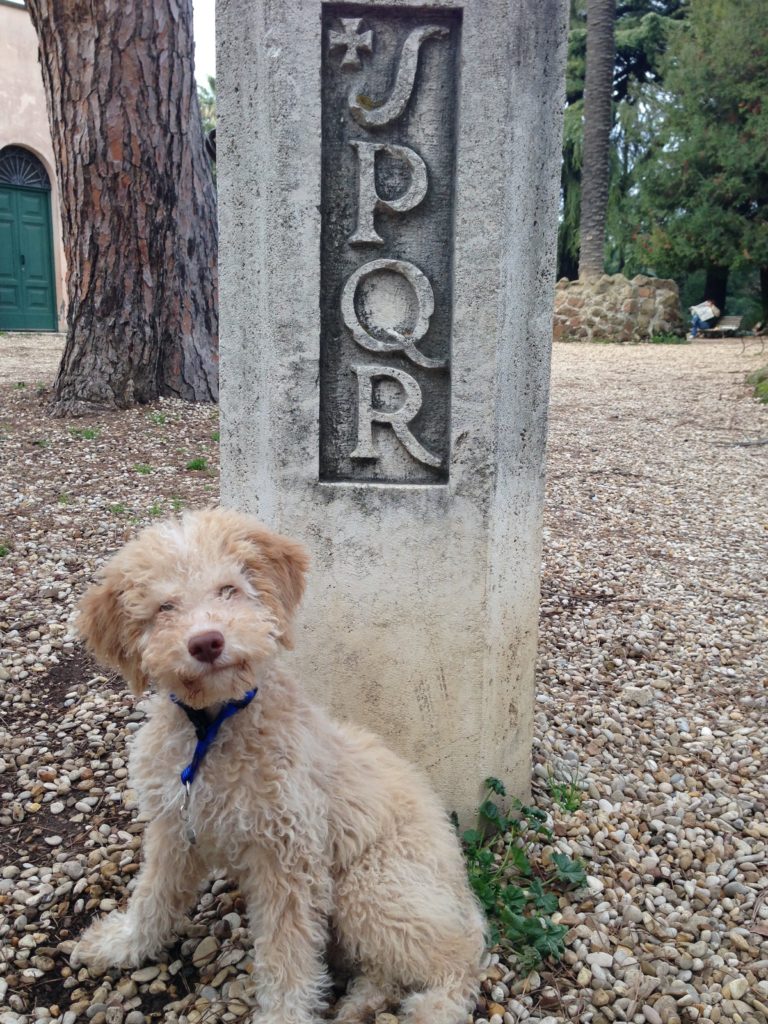Rome is a City of Animals

Rome is a city of swifts, whose arrival close to the day of San Benedetto (March 21) marks for me the beginning of spring.
Their call over Roman roofs is hauntingly beautiful. Is it a warble ? Is it a song ? It is loud, it is profoundly alive, it is high pitched and is usually heard in the chorus of many swifts swooping acrobatically, with magnificent grace, across the silvery morning and evening skies. Every one of a swift’s meals is caught in flight so they are crying out as they are eating, or eating as they are crying.
It is a city of tiger mosquitos whose presence stirs perpetual irritation for Romans : these striped antagonists are so small that you never see them; they strike mostly at the legs.
It is a city of gutsy seagulls that harass most other birds, and that sweep in dramatically to land in piazze where potato chips or pizza bianca discards lie; on my fish monger’s Fiat 500 (he feeds them sardines) and on roofs where they nest and molt and squawk and live animated, bellicose lives.
It is a city of bats that, in spring and summer fly out into the darkening Roman night, taking the stage as the swifts retreat to bed. I love that moment, so quick that you will miss it if you blink.
It is a city where down the street from my daughter’s school, a family of six boars have moved in and take their meals from the neighborhood’s rubbish containers.
It is a city whose emblem is a crouching she wolf, often pictured looking around her shoulder with anxiety, with two greedy babies reaching for her teats. When I was a little girl in Rome, one traditional Sunday activity was to visit the she wolf kept alone in a damp cave-like cage at the foot of the Capitoline hill. The deep misery in her eyes as she looked out at me through stout bars was palpable even to my three-year-old self.
It is a city of rose ringed parakeets visible as wailing green streaks that flash by; they are voluble squawkers, and cause branches, leaves and nuts to plummet suddenly to the ground.
But most of all, Rome is a city of cats and dogs.
The gattara is a figure well known to old school Romans. The gattara, like Anna Magnani, is an emblem of Roman womanhood. She is the person (though there is occasionally a male gattaro) who looks after Rome’s homeless cats. Traditionally the gattara brings the cats the previous night’s spaghetti, or a fish head, or remains from an overabundant second course, all of which is spread out on paper plates (or not) on a newspaper.
The cats await the gattara, and the gattara knows them all by name. There is Massimo, with a head like a grapefruit, and missing an eye; there is Cecilia, with the pointy tail and the loud purr; there is Silvia, who growls if the spaghetti is too close to Massimo. There is Micietta, whom the gattara always showers with strokes and praises for her great beauty. And a whole community more, who, meal completed, and if the weather is fine, make a great show of washing their faces and paws as the gattara clears the table and speaks to each micio in turn. Mild winters make it possible for feral cats to survive year round assuming they are spared a car wheel or another misfortune. Some are abandoned in, or find their way, to one of the city’s private or public cat sanctuaries, and live their lives among capitals and Roman brick work in the sunken Largo Argentina or the cat sanctuary of the Pyramid. The Pyramid cats wander often into the Protestant Cemetery to lounge on the graves. Not so long ago when we went to visit the interior of the pyramid, we found in a tuft of daisies a mother cat chasing butterflies with her kittens. So enchanted were my children that they joined in the game and chose to skip the viewing of the tomb of Gaius Cestius.
My late cat Mew, named for Saint Bartholomew (San Bartolomeo), patron saint of the Tiber island, was born on the island under a mattress in the church square. The gattara that looked after Mew’s mother fed her pasta in the portico of baroque San Bartolomeo, and would no doubt have nourished Mew too had I not been indulged: from among nine kittens, I selected Mew.
Mew came into life to the sound of the rushing river. All her life she felt the pull of water, and when transported to America for four years, chose mostly to be in the bathroom.
Rome casts a long shadow on those of us who were born here.
And then there are the dogs. The Chihuahua Gigante, besotted by my lagotto Teddy, who flops onto his stomach, tail wagging like a metronome, when they meet in our park. Tiramisu’, the Labrador; Suppli’, the spotted white and black mongrel; Susi, the Saint Bernard who longs to join Teddy in the fountains but is too unwieldy and just hangs her great head over the side and drools.
Where I live in Monteverde the dogs are everywhere, but nowhere more than in our park, where they socialize undisturbed by owners who are socializing themselves. They carry pine cones in their mouths and gallop up and down under the dying palms; they run circles around the hibiscus and sniff and urinate on the the granite SPQR (“the senate and people of Rome”) plaque. They lie about, or bark, or yip, or wander. More difficult it would be to find a more compatible group of dogs.
When Mew died, my mother and I, through our tears, took her out the Appian Way. My mother said that she should be buried in the presence of other illustrious Roman women. As it had been raining it was the work of an instant to dig her grave in the fields of San Calisto. We scattered daises atop it and, after some time, raised our heads to the spectacle of hundreds of sheep making their way across the fields, accompanied by a shepherd whose huge umbrella was hoisted across his shoulders.
We leaned back on a wall, and listened to the rich musicality of sheep bells as they drew closer, accompanied by smaller baas and deeper ones.
A lamb, umbilical cord still dragging, became dislocated from its mother and in error approached us; its tiny feet, with animation, danced over Mew’s grave.
The shepherd, his olive-colored face one deep wrinkle, saw, advanced and deftly hooked the lamb’s abdomen with the crook of his umbrella, turning then to locate the appropriate mother, who approached quickly, followed by all of her sisters.
We were engulfed in a circle of wool, of baas, and rich sheep odor.
The shepherd said, after a time : “E’ bello, e ? Bello stare in mezzo alle bestie.”
“It is nice isn’t it, to be among the animals”.
“It is”, we replied. “It is beautiful to be among the animals”.
The swifts soared overhead as we returned to Rome, the city of the animals.
www.insidersitaly.com

Meet Marjorie
Insider’s Italy is an experienced family business that draws on my family’s four generations of life in Italy. I personally plan your travels. It is my great joy to share with you my family’s hundred-year-plus archive of Italian delights, discoveries and special friends.
